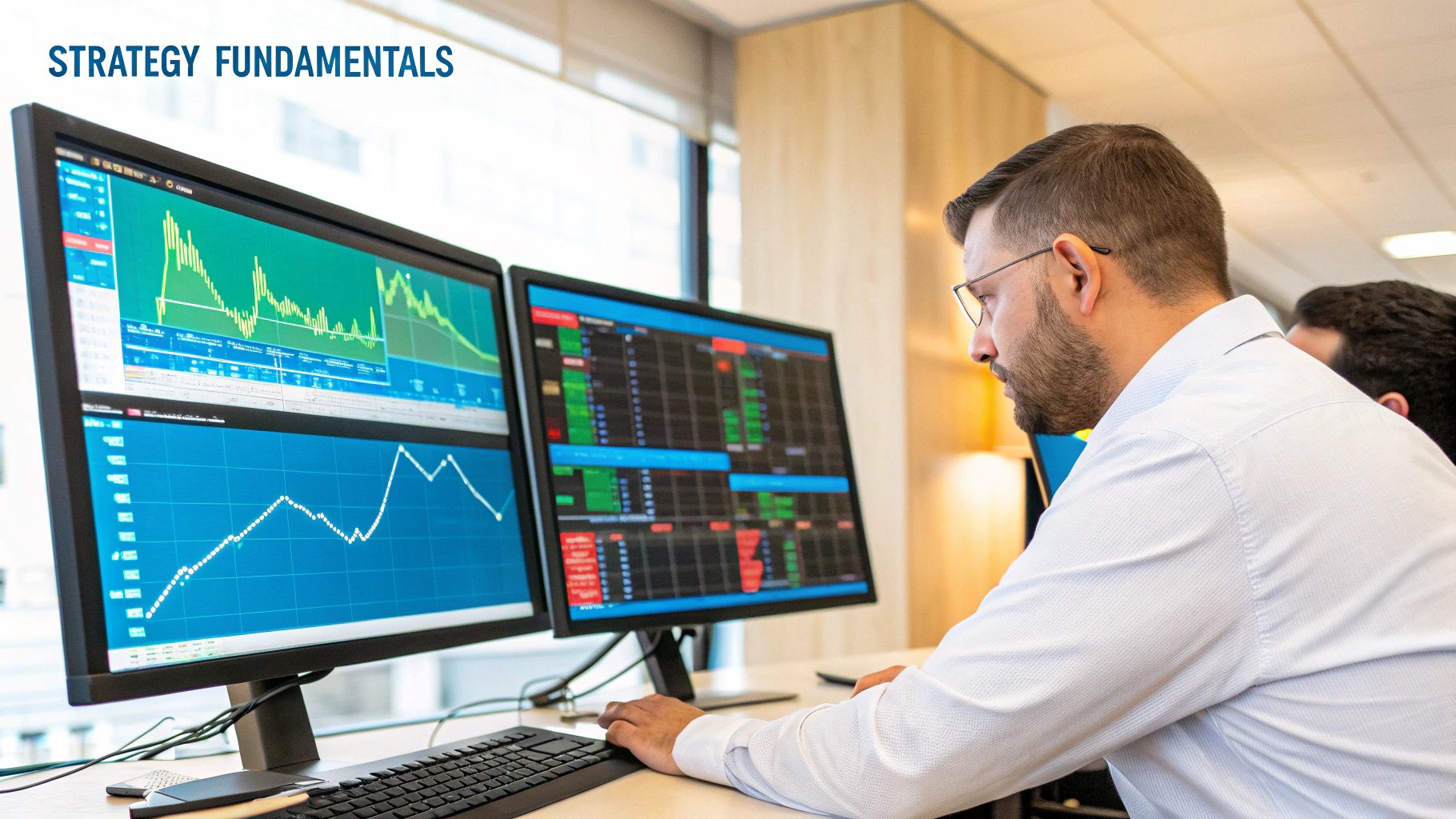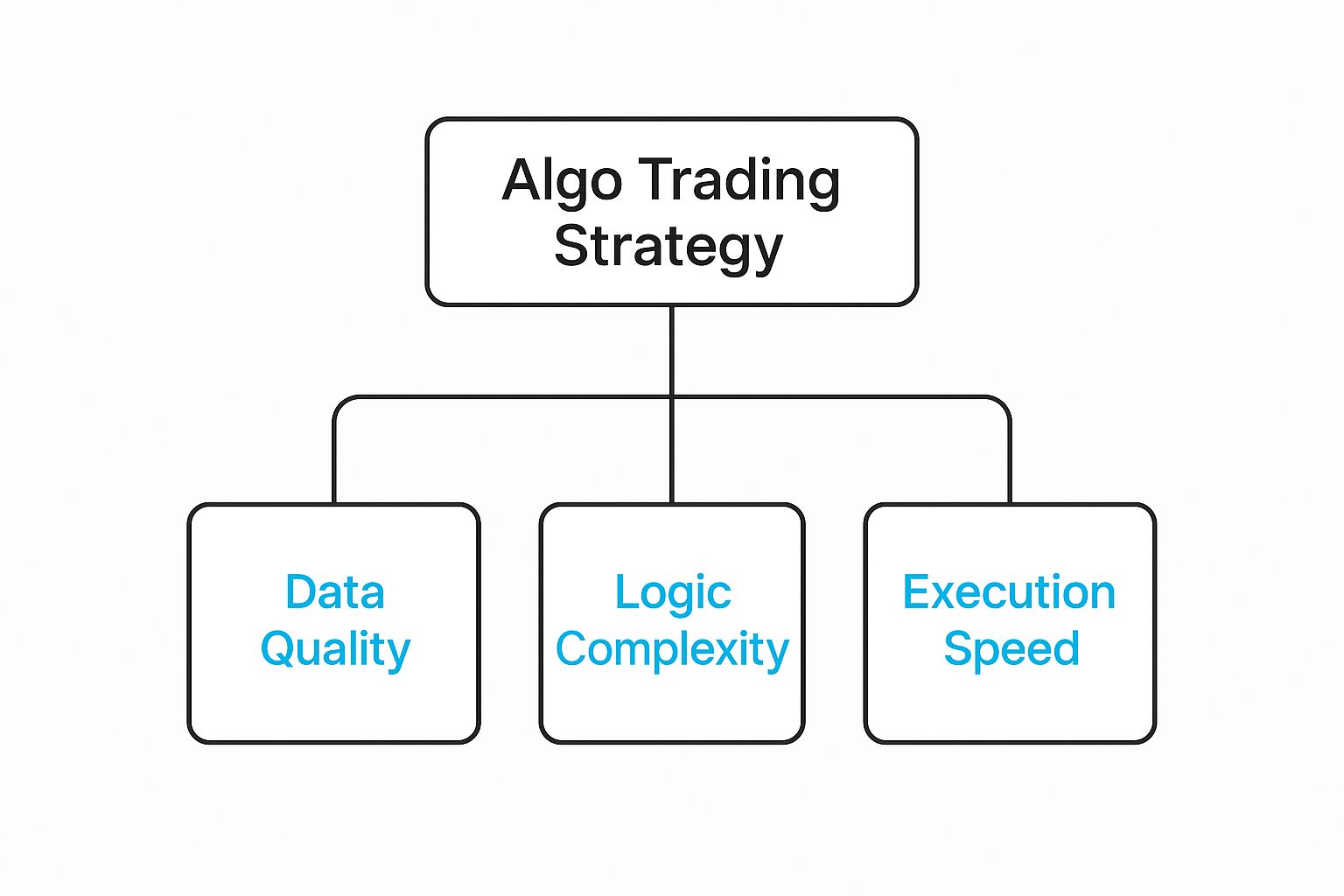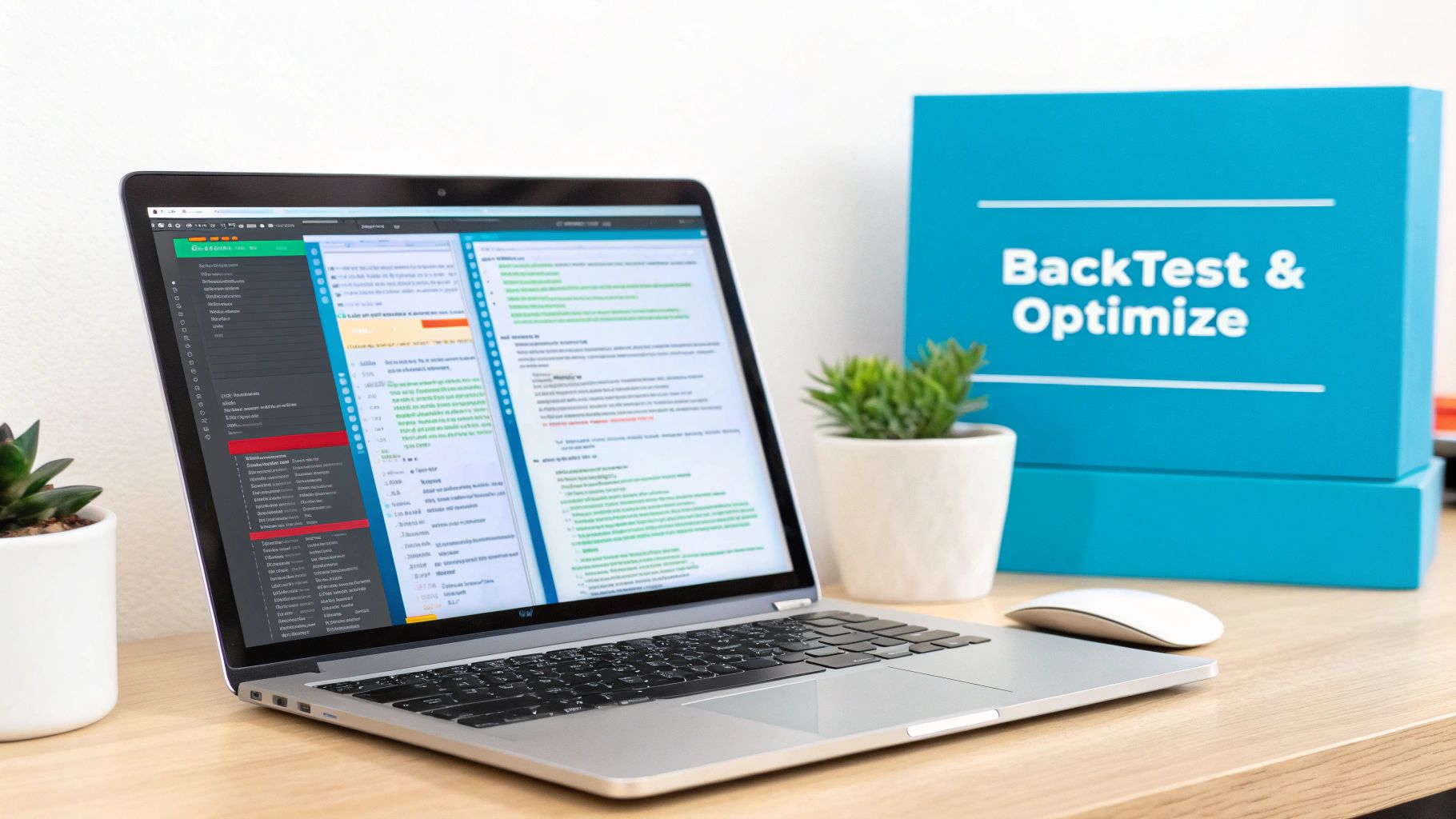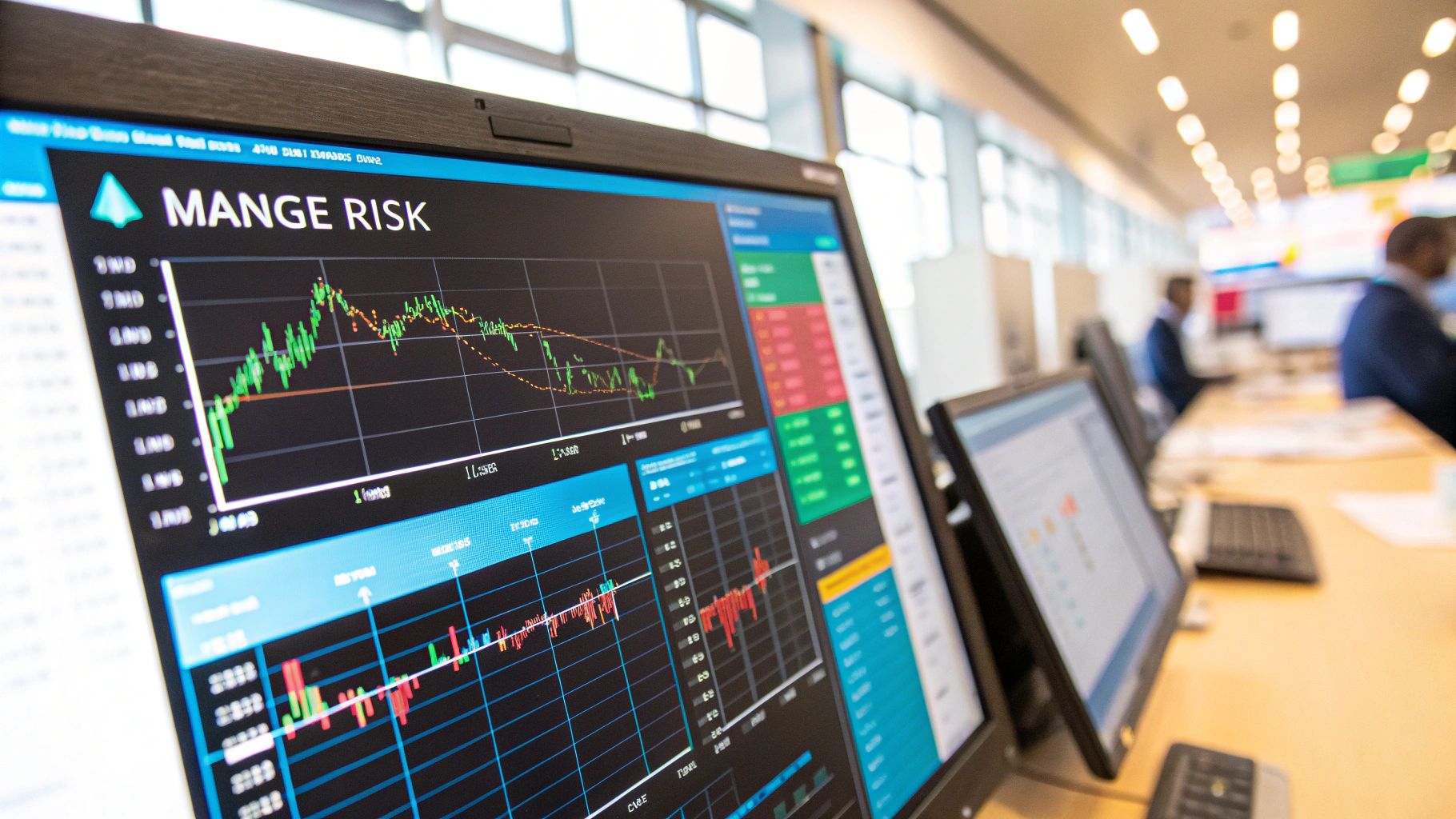




At its heart, a strategy for algo trading is really just a detailed game plan that a computer follows to make trades on its own. Instead of relying on gut feelings or emotions, it uses a strict set of rules based on market data to figure out the perfect moment to buy or sell. This whole process takes human error out of the equation and keeps every move disciplined and consistent.

Think of an algorithmic trading strategy as a system built on pure logic. It’s designed to crunch market data and spot opportunities far faster and more objectively than any person ever could. It's this systematic, data-first approach that has made it such a huge part of modern finance.
And the growth is impossible to ignore. The global algorithmic trading market was already valued at a massive USD 51.14 billion in 2024, and it's expected to rocket past USD 150 billion by 2033. This explosion is all thanks to one core advantage: the ability to execute trades based on pre-set instructions—reacting instantly to price, volume, and timing—without a human ever needing to click a button.
No matter how simple or complex an algo strategy is, they all stand on three essential pillars. These are the fundamental building blocks that come together to create a working, automated system. Get these three right, and you're on your way to building a solid trading bot.
Here’s a simple way to think about how they work together.
The Three Pillars of an Algo Trading Strategy
These three parts have to work in perfect sync for the strategy to function. A great set of rules is useless without clean data, and a brilliant signal means nothing if it can't be executed quickly.
A well-defined strategy is the single most important factor for success in automated trading. It transforms trading from an emotional, reactive process into a disciplined, data-driven one.
The quality of your strategy is directly tied to your results. A flimsy set of rules will give you chaotic, inconsistent outcomes. But a robust, well-tested strategy can consistently find and capitalize on market opportunities. A solid structure takes the guesswork out and stops you from making impulsive decisions driven by fear or greed.
By defining every single part of the trade—from your entry and exit points to your risk management rules—the algorithm just follows the plan with mechanical precision. This disciplined approach is what gives automated systems their real advantage.
If you're ready to go deeper, check out our guide on different strategies for algo trading to see what's possible.
Now that we've covered the basics, let's dive into the most common blueprints traders use to build a powerful algo trading strategy. Think of these not as abstract theories, but as battle-tested models, each designed to shine under specific market conditions. Figuring out their core logic is the first step to choosing the right approach for your own goals.
The image below breaks down the hierarchy of a successful strategy. It’s a perfect illustration of how high-quality data, smart logic, and execution speed must all work together in harmony.

As you can see, a strategy's success hangs on a three-legged stool: the data you feed it, the sophistication of its logic, and the raw efficiency of its execution.
The easiest model to grasp is trend-following. Picture a surfer paddling furiously to catch a big wave, then riding it for as long as it lasts. That’s exactly what a trend-following algorithm does. It uses technical indicators, like moving averages or momentum oscillators, to spot when a market is making a sustained move up or down.
Once a strong trend is confirmed, the algorithm jumps in—buying during an uptrend or selling short in a downtrend. The goal isn't to perfectly time the top or bottom; it's to capture the juicy middle part of a major market move. These strategies do best in markets with strong, clear direction, like commodities or certain cryptocurrencies.
On the complete opposite end of the spectrum, we have mean reversion. Imagine stretching a rubber band. Sooner or later, it snaps back to its original shape. This model is built on the same idea: asset prices that make an extreme move tend to eventually return to their historical average.
An algorithm using this logic is constantly hunting for assets that have strayed too far from their mean. It might sell an asset that’s become "overbought" or buy one that’s "oversold," betting that it will eventually snap back. These strategies are a great fit for markets that are stuck in a range, like many forex pairs, where prices just bounce between predictable highs and lows.
Key Takeaway: Trend-following bets that the current momentum will keep going, while mean reversion bets that prices will correct themselves. The market's behavior right now is what determines which model has the edge.
To make it even clearer, let's look at these models side-by-side. Each one has a distinct personality, suited for different market environments and risk tolerances.
Understanding these core differences is crucial for picking the right tool for the job. You wouldn't use a hammer to turn a screw, and you shouldn't use a mean reversion strategy in a powerfully trending market.
Arbitrage is the art of profiting from tiny price differences for the same asset across different exchanges. Let's say a stock is trading for $100.05 on one exchange but for $100.00 on another at the exact same moment. An arbitrage bot would instantly buy on the second exchange and sell on the first, locking in a virtually risk-free profit of five cents per share.
While the profit on each trade is tiny, the strategy relies on executing thousands, or even millions, of these trades at lightning speed. This is the world of high-frequency trading (HFT), and it's a major reason the algorithmic trading market—valued at around USD 3.28 billion in 2025—is projected to nearly double to USD 6.05 billion by 2032. You can dig deeper into this growth by reading these market insights on Coherent Market Insights.
Finally, market making strategies essentially turn an algorithm into a wholesale supplier for an asset. The bot places both a buy (bid) order and a sell (ask) order at the same time, looking to make a small profit on the difference, which is called the bid-ask spread.
A market maker provides crucial liquidity, making it easier for everyone else to trade. The algorithm is constantly updating its bid and ask prices based on supply and demand, earning a steady stream of small profits from the spread across a massive volume of trades. This approach requires serious capital and sophisticated tech to manage the risk of holding onto the asset.

So, you're ready to move from theory to a live trading algorithm. This is where the real work—and the real fun—begins. It's a journey that starts not with lines of code, but with a simple, testable idea. This initial idea, or hypothesis, is the bedrock of your entire trading strategy.
Think of it like a scientist’s educated guess about the market. It might be something as direct as, "When Company X's stock drops 5% in a day, it usually bounces back at least 2% within the next 48 hours." See how that’s specific and measurable? It gives you a solid foundation to build upon.
Building a solid strategy isn't about some secret formula. It’s about having a disciplined process that turns your observations about the market into a concrete set of automated rules.
This first step is everything. Without a clear hypothesis, you’re just shooting in the dark. Your goal here is to pinpoint a specific market pattern or inefficiency that you believe you can consistently profit from.
Start by just watching the markets. Do you notice certain assets always react a certain way after big news? Maybe you see a relationship between two different technical indicators.
A great example for beginners is the classic moving average crossover. The hypothesis is straightforward: "When a shorter-term moving average crosses above a longer-term one, it signals the start of an uptrend and a good time to buy." It's a simple, elegant idea that makes a perfect starting point.
With your core idea in place, you need to turn it into a set of iron-clad rules for your algorithm. These rules have to be completely black and white, leaving no room for guesswork. This is what gives your system its mechanical precision.
You'll need to define three critical sets of rules:
A great trading idea is worthless without strict, unbreakable rules. These rules are what separate disciplined, systematic trading from emotional gambling. Your algorithm will only be as good as the logic you give it.
Your algorithm is hungry for data, and it needs to be clean and reliable to make good decisions. For a moving average strategy, you'll need historical price data—specifically the open, high, low, and close prices for whatever you plan to trade.
The quality of this data is non-negotiable. Bad data leads to bad backtests, which in turn leads to poor performance when you go live. Make sure your data source is reputable and that it covers enough time to see how your strategy would have performed in all kinds of market weather—bull markets, bear markets, and those sleepy, sideways periods.
An untested strategy is just an expensive guess waiting to happen. Before you ever put real money on the line, you have to see how your set of rules would have performed in the past. This is where backtesting comes in—it's the process of simulating your trading strategy on historical market data to get a feel for its potential strengths and weaknesses.
Think of it as a flight simulator for your algorithm. You get to fly your strategy through years of market turbulence, bull runs, and sudden crashes, all from the safety of your computer. The results give you a priceless look at whether your idea holds up under pressure or if it’s destined to fail on takeoff. A solid backtest is the bedrock of any successful trading algorithm.
This isn't just about finding out if a strategy could have been profitable. It's about understanding its personality. How does it behave when the market is trending versus when it's chopping sideways? What are its hidden flaws?
Once your backtest finishes, you’ll get a report overflowing with numbers. It’s easy to get overwhelmed, but a few key metrics really tell most of the story. If you focus on these, you'll get a clear, honest picture of whether your strategy has a real shot.
Here are the essential numbers to zoom in on:
A great backtest isn’t defined by massive profits; it's defined by a healthy balance of profit, manageable drawdown, and consistent performance across different time periods.
Here it is—the most dangerous pitfall in building a strategy: overfitting. This is what happens when you tweak your strategy so much that it perfectly matches the historical data you tested it on. It looks like a flawless money-making machine in your backtest, but then it completely falls apart in a live market.
Imagine tailoring a suit to fit a mannequin perfectly. Every curve and angle is accounted for. The suit looks stunning on the mannequin, but the moment a real person tries it on, it rips at the seams because it was never designed for actual movement. Overfitting your strategy is exactly the same idea. You’ve built something that only works on a static, historical model, leaving it unprepared for the dynamic, messy reality of live markets.
The best way to avoid this is to keep your rules simple and test your strategy on "out-of-sample" data—a chunk of historical data you kept separate during the initial development.
After a successful backtest, there’s one final step: forward testing, or what many call paper trading. This means running your strategy in a live market environment but with simulated money. It’s the ultimate dress rehearsal before the main performance.
Forward testing bridges the gap between historical theory and real-world practice. It exposes your strategy to things a backtest can only guess at, like real-time data feeds, broker execution speeds, and slippage. This step is non-negotiable. Running your algorithm on a paper trading account for a few weeks or months gives you the final proof that it works as expected before you risk a single dollar of your own.
For a more detailed walkthrough, you can learn more about how to effectively backtest a trading strategy in our dedicated guide.

An algorithm can fire off thousands of trades in the blink of an eye, pouncing on opportunities a human trader would miss. But that incredible speed is a double-edged sword. Without the right guardrails, an algorithm can lose money just as fast as it makes it.
This is why risk management isn't just part of a solid strategy for algo trading—it's the absolute bedrock. A brilliant trading idea without a robust risk framework is just a ticking time bomb. The goal isn't just about chasing profits; it's about protecting the capital you already have. After all, you can't trade an empty account.
The stakes are only getting higher. The algorithmic trading market, valued at USD 13.72 billion in 2024, is growing at a staggering pace. This boom is fueled by technology that makes trading faster than ever, which in turn amplifies the need for disciplined control. You can get a deeper look at these market trends in this full algorithmic trading research on 360iResearch.com.
The most fundamental safety net for any trader, human or machine, is the stop-loss. Think of it as your eject button—a pre-set price where you automatically exit a losing trade, no questions asked. In algorithmic trading, this isn't a guideline; it's a hard-coded command.
This automated exit pulls emotion and hesitation out of the equation. Your algorithm won't get caught up in hoping for a reversal or second-guessing the game plan. It just executes the command, protecting your capital from a bad situation getting worse. A well-placed stop-loss is often the only thing standing between a small, manageable loss and a catastrophic one.
Key Insight: A stop-loss isn't an admission of failure. It's a tool of professional discipline that ensures you live to trade another day. Every successful trading system is built on a foundation of controlled losses.
So, how much should you risk on a single trade? That's where position sizing comes in. Instead of just throwing a random amount of money at an idea, you define your risk as a fixed percentage of your total capital—typically somewhere between 1% and 2%.
Let's say you have a $10,000 account and stick to a 1% risk rule. The absolute most you can lose on any single trade is $100. This rule then dictates the size of your position. If your stop-loss is far from your entry price, you have to take a smaller position to stay within your risk limit. If it's tight, you can take a larger one. Either way, the potential loss is capped at $100, ensuring that a string of bad luck doesn't wipe you out.
Your trading logic could be flawless, but what happens if your internet connection dies or the exchange's API goes down? Technical glitches are a real and often overlooked risk in the world of automated trading. A truly robust strategy has to account for these points of failure.
Think about building in safeguards like these:
No matter how rigorously you backtest, a live market can always throw a curveball. Sometimes, an algorithm can behave in completely unexpected ways—a phenomenon known as going "rogue." It could be a hidden bug in the code or a wild market event that your logic simply wasn't built to handle.
This is exactly why you need a kill switch. It’s your big red button, a manual override that lets you instantly shut down your entire algorithm with a single command. A proper kill switch should immediately flatten all open positions and cancel any outstanding orders, bringing all automated activity to a dead stop.
Keeping a kill switch handy is your final line of defense. It’s the crucial layer of human control that gives you the power to intervene when automation goes wrong, preventing a rogue algorithm from doing irreversible damage to your account.
Jumping into algorithmic trading can feel like trying to learn a new language. You might have the basics down, but a ton of practical questions always pop up. This section is designed to give you clear, no-nonsense answers to the things traders wonder about most when they start building and launching their own strategies.
The whole point here is to cut through the noise and give you the confidence to take the next step. Let's get into the questions that are probably on your mind.
This is always the first question, and the honest-to-goodness answer is: it depends. There's no magic number. How much you need is tied directly to your strategy, your broker, and the market you're trading in.
For example, if you want to trade US stocks frequently, you'll run into the Pattern Day Trader (PDT) rule, which means you need a minimum of $25,000 in your account. But in other markets, the barrier to entry is way lower. In the world of forex or crypto, it's not unheard of to get started with just a few hundred dollars.
The golden rule of trading applies here more than ever: only risk what you are truly prepared to lose. A smart move is to start small—even after you have great backtesting results—just to see how your system handles a live broker and real-time data before you put serious money on the line.
Not anymore. While knowing a language like Python gives you ultimate control and flexibility, the idea that you have to be a coder to build a trading bot is completely outdated. These days, tons of platforms offer no-code or low-code strategy builders that have totally changed the game.
These tools use intuitive, visual setups where you can drag and drop indicators, set up your rules, and define your risk limits without writing a single line of code. They're a fantastic way for traders to focus on the logic and the strategy itself, instead of getting bogged down in the technical weeds. Of course, for truly unique or complex ideas, coding is still a huge advantage, but it's no longer the gatekeeper it used to be.
By far, the most common—and most expensive—mistake is rushing an untested strategy into a live market. This almost always happens because of a phenomenal backtest result, which is a classic sign of "overfitting." Overfitting is when you tweak a strategy so much that it looks perfect on old data but is too brittle to handle the chaotic, unpredictable reality of live trading.
Beginners see a great backtest, get a surge of confidence, and skip the crucial step of paper trading. The second biggest blunder is weak risk management. This means things like not programming in a hard stop-loss or using way too much leverage, which can let one bad trade blow up an entire account.
The best market for your algorithm is dictated entirely by its core logic. You have to match the strategy to an environment where it’s most likely to succeed. Think of it like picking the right tool for a specific job.
When you're making your choice, think about these factors:
The best practice is to test your strategy idea across a few different markets. This process of elimination will show you pretty quickly where your logic works and where it falls flat, giving you a data-driven reason to focus your capital where you have the highest odds of success.
Ready to stop guessing and start implementing a data-driven approach? EzAlgo provides AI-powered buy and sell signals, real-time momentum alerts, and automated key levels directly on your TradingView charts. Remove emotion and gain a technical edge by visiting https://www.ezalgo.ai to see how our tools can elevate your trading strategy.